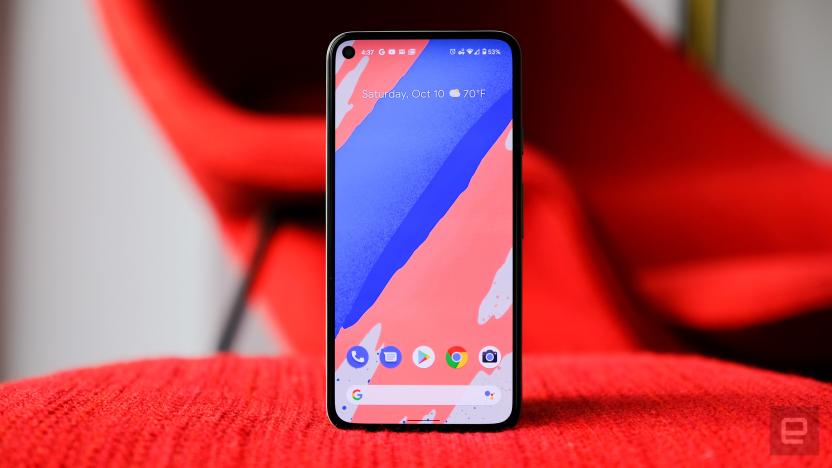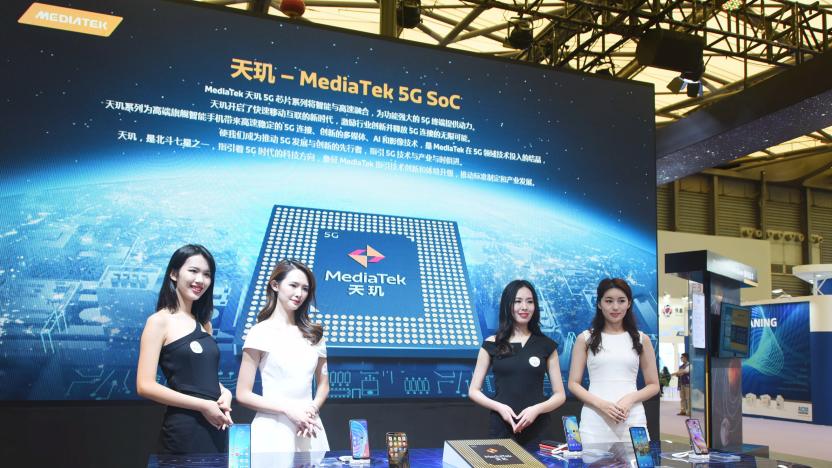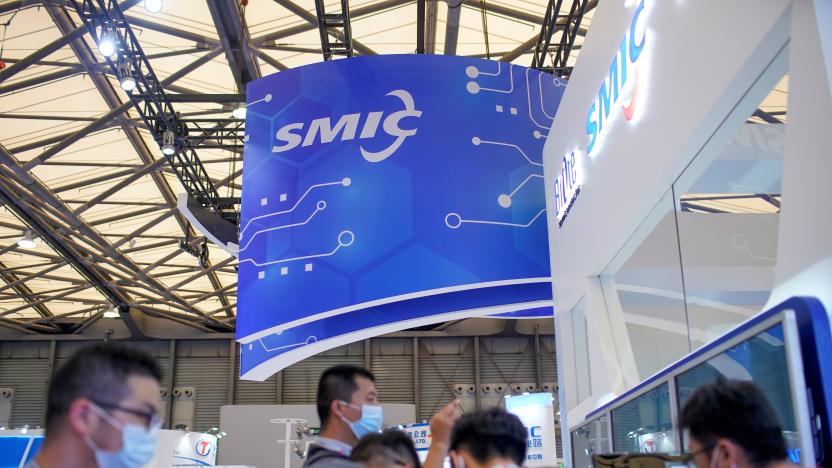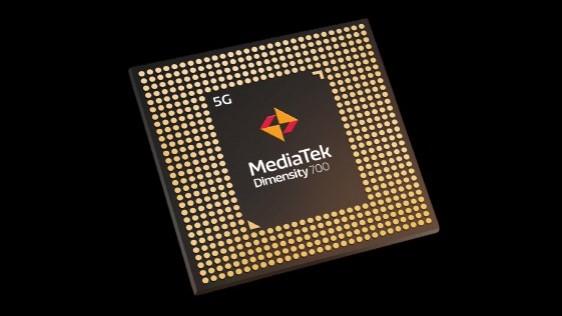chipsets
Latest

Google will reportedly use its own chip in the Pixel 6
According to documentation 9to5Google says it saw, the chipset, codenamed Whitechapel, will power Pixels that are slated to launch this fall.

Report: MediaTek takes over as world's largest smartphone chipset vendor
Move over, Qualcomm: According to a new report from research firm Counterpoint, MediaTek has overtaken the San Diego-based chipmaker to become the world’s biggest vendor of smartphone chipsets by market share. While Qualcomm (understandably) held onto its title as the biggest purveyor of 5G-friendly chipsets, Counterpoint’s data suggests that more than 100 million MediaTek-powered smartphones were sold in Q3 2020 — a roughly five percent increase compared to this time last year. Counterpoint’s report added some valuable context to MediaTek’s most recent earnings release, in which it reported revenues of NT$97,275 million — a boost of nearly 50 percent over the year-ago quarter.

Commerce Department cuts off China’s biggest chipmaker from US tech
US Department of Commerce added dozens of Chinese companies to its Entity List this morning, but one looms especially large. Citing concerns over national security, Semiconductor Manufacturing International Corporation — China’s single largest chip maker — has now effectively been blacklisted from buying components from US tech suppliers. “We will not allow advanced U.S. technology to help build the military of an increasingly belligerent adversary,” said Commerce Secretary Wilbur Ross.

MediaTek's latest Chromebook chipsets balance battery life and power
The company also announced an addition to its lineup of mobile 5G CPUs.

Researchers discover that Intel chips have an unfixable security flaw
Security researchers have discovered another flaw in recent Intel chips that, while difficult to exploit, is completely unpatchable. The vulnerability is within Intel's Converged Security and Management Engine (CSME), a part of the chip that controls system boot-up, power levels, firmware and, most critically, cryptographic functions. Security specialists Positive Technologies have found that a tiny gap in security in that module that could allow attackers to inject malicious code and, eventually, commandeer your PC.

Apple will reportedly replace Intel chips in Macs with its own in 2020
Apple has been manufacturing chips to use in its Macs for a while now, though the ARM-based silicon mostly backs up Intel's main CPUs during laptop "Power Nap" sessions. The company also makes its own silicon for iOS and Apple Watch devices. Now, according to a report at Bloomberg, Apple plans to replace Intel's Mac chips, starting as early as 2020.

How Qualcomm aims to be everywhere -- not just phones
Qualcomm already rules the mobile world -- now it wants to tackle all of the other gadgets in your life. But none of this should be a surprise if you've been paying attention. Its Snapdragon chips already power most high-end smartphones, so it makes sense for Qualcomm to leverage that experience into chips for wearables, cars, home appliances and more. The company is even eyeing the server market, a move that should have Intel shaking in its hermetically sealed bunny boots.

ARM's Mali-T604 makes official debut, we get a first look at the next-gen GPU (hands-on video) (update: it's the Exynos 5)
Think those are some pretty slick graphics in your Galaxy S III? Samsung's latest smartphone packs some mighty graphics prowess of its own, thanks to the Mali-400 MP GPU, but once you spend a few minutes with the Mali-T604, the company's next-generation chipset, the improvements become quite clear. After seeing the Mali-T604 in action, as we did at SIGGRAPH today, the capabilities leave us hopeful for the future, and perhaps feeling a bit self-conscious about the silicon currently in our pockets. The reference device on hand was operating in sync with a variety of unnamed hardware, protected from view in a relatively large sealed box. We weren't able to squeeze many details out of ARM reps, who remained mum about the demo components, including clock speed, manufacturer and even fabrication size. What we do know is that we were looking at a quad-core Mali-T604 and dual-core ARM Cortex-A15 processor, with a fabrication size in the range of "28 to 40 nanometers" (confirming the exact size would reveal the manufacturer). Clock speed is also TBD, and the early silicon on demo at the show wasn't operating anywhere close to its top end. In order to experience the T604, we took a look at three demos, including Timbuktu 2, which demonstrates elements like self shadowing and depth of field with OpenGL ES 3.0, Hauntheim, which gives us an early look at physics simulation and HDR lighting with OpenCL, and Enlighten, which rendered silky smooth real-time illumination. You can see all of the demos in action after the break, and you can expect T604-equipped devices to make their debut beginning later this year -- ARM says its working with eight manufacturers to get the licensed tech to market as early as Q3. Update: ARM has just confirmed to us that this reference device is running off an Exynos 5 Dual chip (up to 1.7GHz), which means the following video is also a heads-up on what Sammy has in store for us in its forthcoming devices.%Gallery-161934%

Qualcomm enlists Samsung, UMC to help meet 28nm Snapdragon S4 demand
Qualcomm's Snapdragon S4 chipset is certainly hot (well, not too hot), but it looks like demand is expected to grow even further, causing the San Diego-based SoC maker to turn to allies in the east to help beef up supply. According to China Economic News Service, United Microelectronics Corp. (UMC) and Korea-based Samsung will join Taiwan Semiconductor Manufacturing Co. (TSMC) to manufacturer the 28nm chips beginning later this year, in an attempt to increase S4 availability ahead of the Windows RT launch. The article cites Qualcomm CEO Paul Jacobs as saying that a shortage is expected to continue, due to the complicated techniques necessary to manufacturer 28nm chips, and that the company may consider adding its own manufacturing plant in the future. All in all, it doesn't seem like a terrible position for QCOM to be in. Full details are at the Taiwanese source link below.

Micron scoops up Elpida Memory, 50-percent production boost for $2.5 billion
There's no question that Micron has shifted its focus away from PCs in favor of producing components, shipping everything from SSDs to CMOS sensors in recent years, but the semiconductor manufacturer just took a $2.5 billion step even closer to bridging its gap between other companies in the same market, including Samsung, the chip producer's top competitor. Under the deal, Elpida Memory, which is headquartered in Tokyo, will fall within the Idaho-based conglomerate's growing umbrella, netting Micron a 50-percent boost in production capability. That increase did come at great expense, however -- the transaction included $750 million in cash and $1.75 billion in future installments (1,750 easy payments of one million dollars?), which are set to continue through 2019. The acquisition was also paired with a 24-percent stake in Rexchip Electronics for an additional $334 million, which will complement Elpida's investment, yielding a total 89-percent stake for Micron. While the amount does seem quite significant, investors appear to be on board, with Micron's stock ($MU) currently up more than 4 percent since this morning. Both deals will reportedly close within the next year.

Engadget Primed: why nanometers matter (and why they often don't)
Primed goes in-depth on the technobabble you hear on Engadget every day -- we dig deep into each topic's history and how it benefits our lives. You can follow the series here. Looking to suggest a piece of technology for us to break down? Drop us a line at primed *at* engadget *dawt* com. Welcome to one of the most unnecessarily complicated questions in the world of silicon-controlled gadgets: should a savvy customer care about the underlying nature of the processor in their next purchase? Theoretically at least, the answer is obvious. Whether it's a CPU, graphics card, smartphone or tricorder, it'll always receive the Holy Grail combo of greater performance and reduced power consumption if it's built around a chip with a smaller fabrication process. That's because, as transistors get tinier and more tightly packed, electrons don't have to travel so far when moving between them -- saving both time and energy. In other words, a phone with a 28-nanometer (nm) processor ought to be fundamentally superior to one with a 45nm chip, and a PC running on silicon with features etched at 22nm should deliver more performance-per-watt than a 32nm rival. But if that's true, isn't it equally sensible to focus on the end results? Instead of getting bogged down in semiconductor theory, we may as well let Moore's Law churn away in the background while we judge products based on their overall user experience. Wouldn't that make for an easier life? Well, maybe, but whichever way you look at it, it's hard to stop this subject descending into pure philosophy, on a par with other yawnsome puzzles like whether meat-eaters should visit an abattoir at least once, or whether it's better to medicate the ailment or the person. Bearing that in mind, we're going to look at how some key players in the silicon industry treat this topic, and we'll try to deliver some practical, offal-free information in the process.

MediaTek sees no reason cheap phones can't have Ice Cream Sandwich too
If you don't want to drop $300 on a phone we don't blame you -- honestly, the idea makes us feel a bit dirty too. MediaTek doesn't seen any reason for it either. The company has been working its way in to the mobile chipset business for a little while now, and its latest is aimed squarely at the lower end of the handset spectrum but still promises to deliver the latest in dessert-themed operating systems. The MT6575 is a single core Cortex-A9 solution with an unidentified 5-series PowerVR GPU on board and an HSPA modem. The 1GHz core probably won't win and benchmark competitions, but it's enough to push Android 4.0 to a qHD screen, power through 720p video and capture shots with an 8 megapixel sensor. It even is capable of supporting 3D displays and DTV broadcasts -- not too bad for something destined to wind up in $50 smartphones. Checkout the complete PR after the break.

Intel and MasterCard to offer Ultrabook users 'safer' NFC checkout via PayPass, impulsive shoppers rejoice
Entering a 16-digit credit card number may be a thing of the past with a new initiative from MasterCard and Intel, which allows users to checkout online by tapping a PayPass-enabled card, tag or smartphone to their Ultrabook. Calling the checkout "safer" and "simpler," Intel is bringing its Identity Protection Technology to the potluck, giving shoppers two-factor authentication and chip-based display protection when forking over that hard earned cash. Here's how it all works: when you tap a NFC smartphone or other PayPass-enabled device, it will communicate with the Ultrabook, generating a six-digit code from the embedded processor or from within the Manageability Engine. The ME hardware, encrypted with third-party algorithms, then transacts with the e-commerce site, hopefully offering shoppers more protection than standard software solutions. Since using the feature requires an NFC-connected device as well as the Ultrabook and a username and password, forgetful folks who tend to misplace their phone or computer won't have to worry about unwarranted spending. Sadly, the solution won't protect your wallet from the perils of a late night shoe shopping spree. Check out the full PR after the break.

MSI demos X79 motherboards with PCI Express 3.0 and UEFI BIOS at IDF 2011 (video)
While MSI wasn't quite ready to publicly divulge all the details of its forthcoming X79-based motherboards, it was more than happy to give us a teaser. We were shown three upcoming models from the company at IDF, all toting PCI Express 3.0 slots, overclocking buttons and that snazzy UEFI BIOS. The latter makes changing settings a snap, and is carried over from the company's existing Sandy Bridge boards -- it even comes with a button that launches a browser, but unfortunately the machines in the booth weren't configured to support it. We'll know more in Q4, but in the meantime a gallery awaits you below, along with a video after the break. Myriam Joire contributed to this report. %Gallery-134332%

Apple considering TSMC mobile chips?
We hope you're ready for a heaping helping of Apple speculation, because Reuters is serving up a nice big slice of rumor pie today. According to the ever-present "source with knowledge of the matter," Taiwanese chipmaker, TSMC is gearing up to supply Apple with its next generation mobile processors. According to the apparently credible anonymous source, TSMC has already begun trial manufacturing on the chips and "has got all the authorization and details ready." As you may already know, Apple's current supplier of its A5 CPU is Samsung, and relations between the two have been rocky (at least in court). This round of speculation also comes just one year after TSMC began construction on its new $9.3 billion foundry, and teamed up with ARM -- the brains behind the A5. Of course all parties have declined to comment, which lands this report squarely in the grapevine for now, but we'll keep you posted if it winds its way into reality.

AMD beats Intel to the punch, confirms USB 3.0 support in future chipsets
When a leaked document strongly suggests that Intel's upcoming Panther Point chipset will support USB 3.0, AMD's not going to take that cheery news lying down. Not even a day later, the underdog chip maker has confirmed that its A75 and A70M Fusion chipsets will support the standard protocol, which claims speeds ten times faster than USB 2.0. No word on when that'll happen, or whether AMD will beat Chipzilla to market -- but if nothing else it can brag about being first out of the gate with an official plan. Huzzah!

WebM VP8 specs ready for chip companies to start building hardware acceleration
You know how long we've been waiting for Flash video to get decent hardware acceleration? Well, it looks like the Google-backed WebM VP8 codec won't take nearly so long. The WebM hardware development team just pushed out hardware decoder IP for VP8, which will let chip folks build WebM playback into their chipsets -- most of which are currently oriented around accelerating H.Google's-gunning-for it-264 and / or Flash. A VP8 hardware encoder IP will follow later in Q1. There's nothing much more to it: it's the same ol' 720p and 1080p decoding we know and love, which will be possible on mobile devices (and already is with other codecs), but this time it's open, remember?

Intel learns from Dr. Dre, wants Atom chips in NFL helmets to know when heads are ringing
We always understood that Intel looked after the rock stars of tomorrow, but who knew that included football players? Yup, according to PC World, Intel is currently investigating adding Atom chips inside NFL helmets to provide real-time impact data to medical staff on the sidelines. While there's no explicit time frame set for this project, we're thinking the sooner the better -- lest we forget it took the league until 2009 to require players who display signs of a concussion to stop playing for at least one day. This isn't the first time though that the world's largest chip maker has actually helped make the gridiron safer. In fact, it previously worked with helmet maker Riddell's fittingly named HITS (Head Impact Telemetry System) and academic researchers to run head injury simulations using linked Xeon-powered computers. Off the field, Intel is also currently partnering with the Mayo Clinic to boost medical cranial scans using MIC (Many Integrated Core) supercomputer co-processors. Codenamed Knights Corner, this hardware puts teacher's pets to shame by running trillions of calculations per second, and apparently accelerates head scans by up to 18 times. Sure, safety's all well and good, but we know Intel's really just curious about how Moore's Law holds up to the shoulder pressure of NFL d-backs.

Intel Chief River laptop platform to support USB 3.0, arrive in 2012?
Another Intel processor platform that sounds like a campground? Of course it is! This one is pretty far out -- like 2012 far out -- but if Digitimes is to be believed Intel's actually gearing up to reveal its Chief River laptop platform at CES in January. Said to be based on the 22nm Ivy Bridge processors and have native support for USB 3.0 (finally!), the platform would follow Huron River / Sandy Bridge, which is set to start shipping in laptops in early 2011. (Side note: Digitimes also mentions that we should start seeing Sandy Bridge laptops at this year's CES, which lines up with what we've heard from our own sources.) The word from motherboard manufacturers is that Chief River wouldn't actually go into mass production until September 2011 and start shipping in systems until January 2012, which makes quite a bit of sense given Intel's annual timing on these things. Either way, we should be finding out more in a couple months in Vegas -- heck, you never know, Intel may even tell us a bit about its 2013 laptop platform. Shall we give them a hand with potential names?

Jen-Hsun Huang is 'looking forward' to court date with Intel, sees no reason to settle (video)
Sometimes companies spar out their differences behind closed doors, and sometimes they have guys like Jen-Hsun Huang at their helms and the whole world gets to know how they feel and what they intend to do about it. The Tegrasaurus Rex has taken a recent interview with Fortune magazine as an opportunity to eloquently lay out his side's case in the epic cross-licensing dispute between NVIDIA and Intel, and to let us all know that he sees "no reason" to settle with the Atom-making giant. Describing Intel's argumentation as "completely nonsense," NVIDIA's fearless leader tell us that he's eagerly anticipating the court clash scheduled for later this year. We can't yet confirm whether or not he finished it off with a "bring your popcorn" instruction, but all his recorded words await in video form just after the break.













